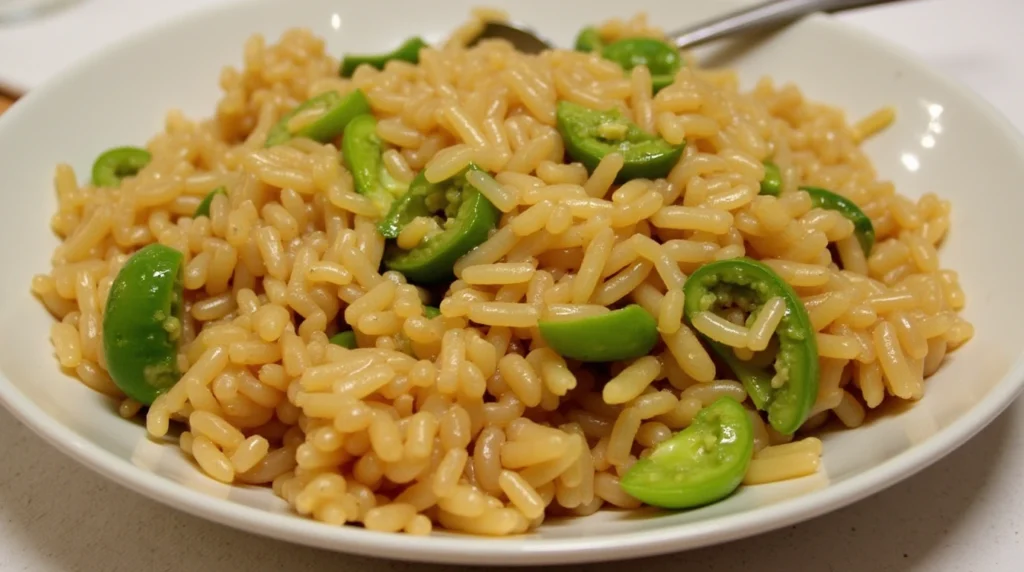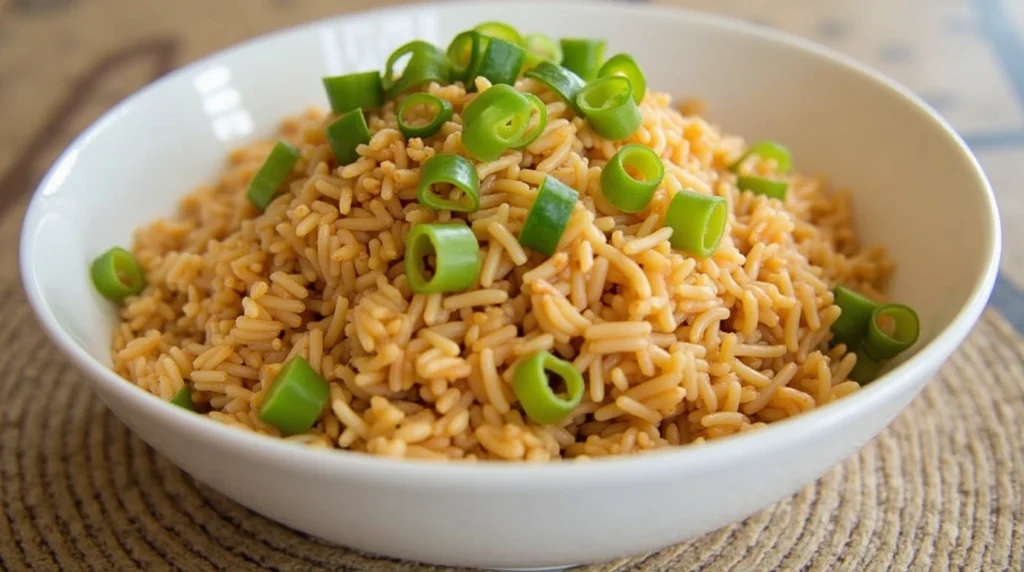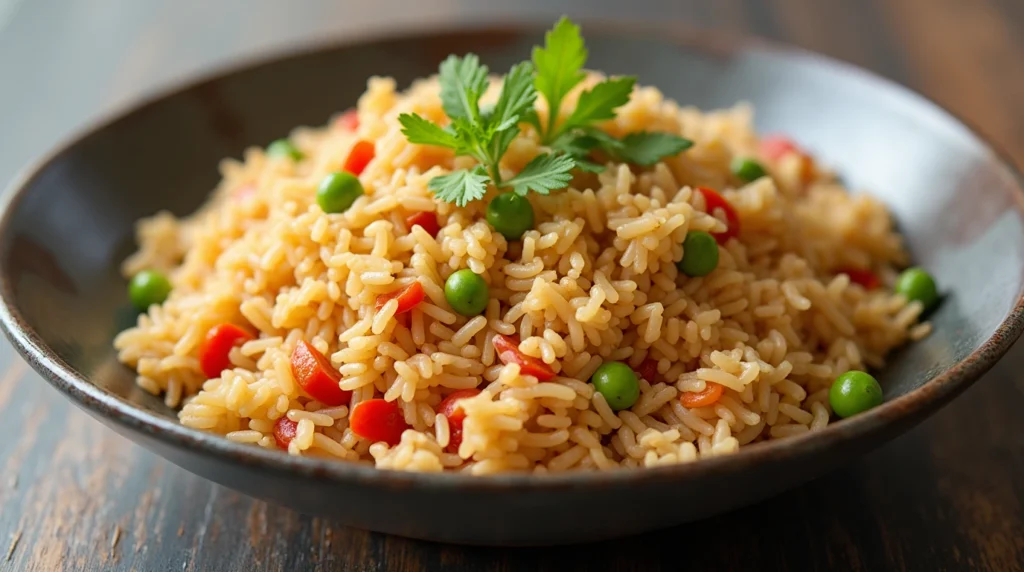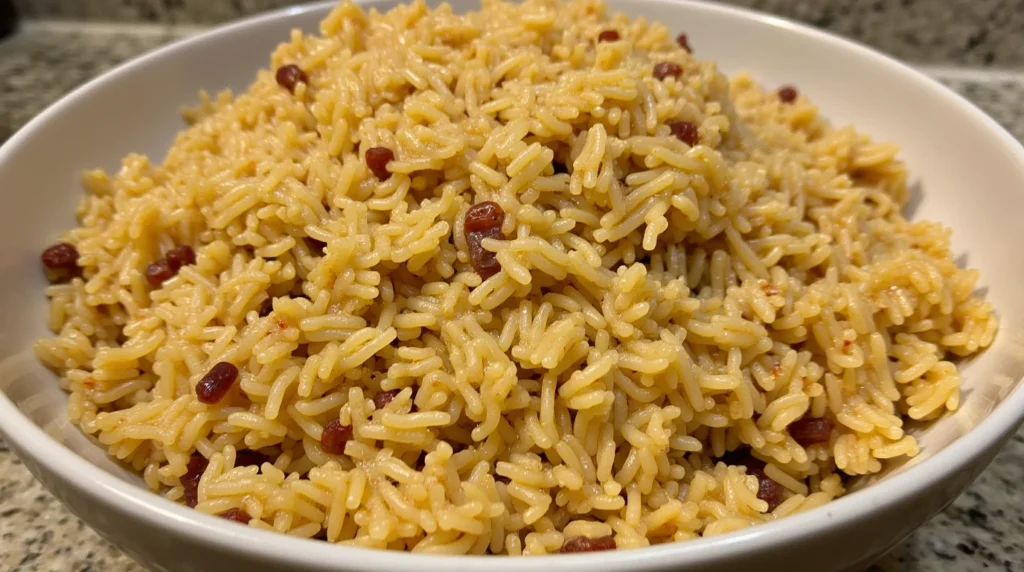Introduction

Have you ever wondered what makes stir-fried rice such a beloved dish across the globe? Imagine this: you come home after a long day, open your fridge, and find leftover rice, a few vegetables, and maybe some chicken or shrimp. With just a little effort and the right technique, you can transform these humble ingredients into a meal that’s bursting with flavor and warmth. That’s the magic of stir-fried rice—a dish that’s not only delicious but also deeply rooted in tradition.
Stir-fried rice has been a staple in Asian cuisine for centuries, celebrated for its simplicity, versatility, and ability to bring people together. Whether you’re cooking for yourself or feeding a family, it’s the ultimate comfort food that adapts to whatever ingredients you have on hand. In this article, we’ll explore what stir-fried rice is, where it comes from, how to make it perfectly, and why it’s become such a popular choice for quick, flavorful meals. Let’s dive in!
1. What is Stir-Fried Rice? Understanding the Basics
1.1 The Origins of Stir-Fried Rice
- Stir-fried rice traces its roots back to Chinese cuisine , where it was originally created as a way to use leftover rice.
- Over time, the dish spread across Asia, adapting to local tastes and ingredients in countries like Thailand, Japan, and Korea.
- Fun fact: Stir-frying itself is an ancient cooking technique designed to cook food quickly over high heat, preserving nutrients and flavors.
1.2 Key Ingredients in Stir-Fried Rice
- At its core, stir-fried rice includes:
- Rice : Jasmine, basmati, or brown rice are popular choices.
- Soy sauce : Adds umami and depth of flavor.
- Vegetables : Think carrots, peas, bell peppers, and broccoli.
- Aromatics : Garlic and ginger are must-haves for that signature taste.
- Optional proteins: Chicken, shrimp, tofu, or eggs can take your stir-fried rice to the next level.
1.3 The Stir-Frying Technique
- The secret to great stir-fried rice lies in using high heat and a wok or large skillet.
- Preheat your pan before adding oil (like sesame or peanut oil) to prevent sticking and ensure even cooking.
- Stir constantly to achieve that perfect sear without burning the ingredients.
1.4 Why Stir-Fried Rice is So Popular
- It’s quick: You can whip up a batch in under 15 minutes.
- It’s adaptable: Use whatever ingredients you have on hand.
- It’s comforting: The combination of textures and flavors makes it irresistible.
2. How to Make Perfect Stir-Fried Rice at Home
2.1 Choosing the Right Type of Rice
- For best results, use day-old rice . Freshly cooked rice tends to be too moist and can turn mushy.
- Popular options include:
- Jasmine rice: Fragrant and slightly sticky.
- Basmati rice: Light and fluffy.
- Brown rice: Nutty flavor and higher fiber content.
2.2 Step-by-Step Cooking Instructions
- Heat your wok or skillet over high heat.
- Add a tablespoon of oil and sauté minced garlic and ginger until fragrant.
- Toss in your protein (if using) and cook until done.
- Add chopped vegetables and stir-fry until tender-crisp.
- Finally, add the rice and season with soy sauce, sesame oil, or other sauces. Stir well to combine.
2.3 Flavor Enhancers for Stir-Fried Rice
- Boost the flavor with:
- Soy sauce or tamari for saltiness.
- Oyster sauce for richness.
- Sriracha or chili flakes for heat.
- Garnish with fresh herbs like cilantro or green onions for brightness.
2.4 Common Mistakes to Avoid
- Don’t overcrowd the pan; this lowers the heat and leads to soggy rice.
- Avoid overcooking vegetables—they should retain some crunch.
- Resist the urge to stir too infrequently; constant stirring prevents burning.
3. Variations of Stir-Fried Rice to Try
3.1 Vegetable Stir-Fried Rice
- A vegetarian-friendly option packed with colorful veggies like carrots, peas, and bell peppers.
- Perfect for vegan and low-carb diets .
3.2 Chicken Stir-Fried Rice
- Cook diced chicken breast or thighs and pair with scrambled eggs for added richness.
- Season with soy sauce and garnish with green onions.
3.3 Shrimp Stir-Fried Rice
- Sauté shrimp quickly to avoid overcooking. Pair with garlic and ginger for a seafood twist.
- Serve with a squeeze of lime for extra zest.
3.4 Leftover Rice Stir-Fry
- Get creative by tossing in frozen veggies, eggs, or leftover meats.
- A lifesaver for busy weeknights when you need a quick meal.
4. Health Benefits of Stir-Fried Rice
4.1 Nutrient-Rich Ingredients
- Vegetables provide vitamins and minerals, while lean proteins like chicken or tofu offer muscle-building benefits.
- Whole grains like brown rice contribute fiber and sustained energy.
4.2 Low-Carb and Gluten-Free Options
- Swap regular rice for cauliflower rice to reduce carbs.
- Use gluten-free tamari instead of soy sauce if needed.
4.3 High-Protein Stir-Fried Rice
- Incorporate eggs, chicken, shrimp, or tofu for a protein-packed meal.
- Ideal for fitness enthusiasts looking to fuel their bodies.
4.4 Portion Control and Balanced Meals
- Serve stir-fried rice alongside steamed greens or a light soup for a balanced plate.
- Practice mindful eating by savoring each bite.
5. Tips for Elevating Your Stir-Fried Rice Game
5.1 Mastering the Wok Technique
- Preheat your wok before adding oil to create a nonstick surface.
- Stir constantly to distribute heat evenly and prevent burning.

5.2 Experimenting with Sauces
- Try hoisin sauce, fish sauce, or curry paste for unique flavor profiles.
- Customize based on your personal preferences.
5.3 Adding Fresh Herbs and Garnishes
- Fresh cilantro, green onions, or sesame seeds add visual appeal and enhance flavor.
- Garnishing elevates the dish from simple to restaurant-quality.
5.4 Storing and Reheating Stir-Fried Rice
- Store leftovers in an airtight container in the fridge for up to 3 days.
- Reheat in a skillet or microwave, adding a splash of water to refresh the texture.
Recipe Table – Basic Stir-Fried Rice Ingredients
| Ingredient | Quantity | Notes |
|---|---|---|
| Rice | 2 cups (cooked) | Preferably day-old |
| Soy Sauce | 2 tbsp | Adjust to taste |
| Garlic | 2 cloves | Minced |
| Ginger | 1 tsp | Grated |
| Vegetables | 1 cup | Carrots, peas, bell peppers |
| Protein (optional) | 1 cup | Chicken, shrimp, or tofu |
| Oil | 1 tbsp | Sesame or peanut oil |
6. The Cultural Significance of Stir-Fried Rice Across Asia
Stir-fried rice isn’t just a dish—it’s a cultural icon that reflects the history, traditions, and values of the regions where it’s prepared. Understanding its cultural significance can deepen your appreciation for this humble yet versatile meal.
6.1 Stir-Fried Rice in Chinese Cuisine
- In China, stir-fried rice is often served during festivals and family gatherings as a symbol of prosperity and abundance.
- Variations like Yangzhou Fried Rice (a colorful mix of shrimp, ham, eggs, and vegetables) showcase the diversity of Chinese culinary techniques.
- Fun fact: The use of leftover rice in stir-fries aligns with the Chinese philosophy of minimizing waste—a principle deeply ingrained in their culture.
6.2 Stir-Fried Rice in Japanese Cuisine
- Japan’s version of stir-fried rice, known as Chahan , incorporates local ingredients like dashi (a savory broth) and pickled ginger.
- Chahan is often paired with other dishes like tempura or miso soup, making it a staple in bento boxes and casual meals.
- It’s also a popular choice at izakayas (Japanese pubs), where it’s served as a comforting late-night snack.
6.3 Stir-Fried Rice in Southeast Asia
- In Thailand, Khao Pad (Thai fried rice) is flavored with fish sauce, lime juice, and fresh herbs like cilantro and basil.
- Malaysia and Singapore have their own take with Nasi Goreng , which includes sweet soy sauce (kecap manis) and spicy sambal for a bold flavor profile.
- These regional variations highlight how stir-fried rice adapts to local tastes while maintaining its core simplicity.
6.4 Stir-Fried Rice as a Global Dish
- Thanks to globalization, stir-fried rice has become a global phenomenon. From fusion dishes like Korean kimchi fried rice to Tex-Mex-inspired versions with beans and cheese, the possibilities are endless.
- Its universal appeal lies in its ability to bring people together, whether it’s a home-cooked meal or a street food favorite.
7. Tools and Equipment You Need for Perfect Stir-Fried Rice
While stir-fried rice is simple to make, having the right tools can elevate your cooking experience. Here’s what you’ll need:
7.1 The Wok: Your Best Friend in the Kitchen
- A carbon steel wok is ideal for stir-frying because it distributes heat evenly and develops a natural nonstick surface over time.
- If you don’t have a wok, a large skillet or frying pan works too, but it won’t provide the same level of heat retention.
7.2 Essential Utensils
- Spatula : A flat spatula with a wide surface area helps you toss and stir ingredients efficiently.
- Tongs : Useful for handling proteins like chicken or shrimp without burning your fingers.
- Measuring spoons : For precise seasoning with sauces like soy sauce or oyster sauce.
7.3 Optional Gadgets
- Rice cooker : Ensures perfectly cooked rice every time, especially if you’re preparing larger batches.
- Mandoline slicer : Makes chopping vegetables quick and uniform, saving you prep time.
- Immersion blender : Handy for making homemade sauces like chili oil or curry paste.

8. Advanced Techniques for Mastering Stir-Fried Rice
Once you’ve mastered the basics, it’s time to level up your stir-fried rice game with these advanced techniques:
8.1 Achieving Wok Hei (Breath of the Wok)
- Wok hei is the smoky, charred flavor that comes from cooking at extremely high heat. To achieve it:
- Preheat your wok until it’s smoking hot before adding oil.
- Cook in small batches to avoid lowering the temperature.
- Use a fan or open window to ventilate your kitchen—this technique produces a lot of smoke!
8.2 Layering Flavors
- Start by sautéing aromatics like garlic and ginger to build a flavor base.
- Add proteins next, followed by harder vegetables (like carrots) before softer ones (like spinach).
- Finish with sauces and garnishes to tie everything together.
8.3 Experimenting with Regional Spices
- Incorporate spices like Sichuan peppercorns for a numbing heat or turmeric for an earthy aroma.
- Try blending different spice profiles to create unique fusion dishes.
9. Pairing Stir-Fried Rice with Other Dishes
Stir-fried rice doesn’t have to be eaten alone—it pairs beautifully with a variety of side dishes. Here are some ideas:
9.1 Soups and Broths
- Serve stir-fried rice alongside clear soups like miso soup or chicken broth for a light yet satisfying meal.
- For something heartier, pair it with creamy coconut milk-based curries.
9.2 Salads and Greens
- A crisp cucumber salad or blanched bok choy adds freshness and balances the richness of stir-fried rice.
- Drizzle sesame dressing or sprinkle toasted sesame seeds for extra flavor.
9.3 Appetizers and Snacks
- Start your meal with spring rolls, dumplings, or edamame to complement the main dish.
- End with a sweet treat like mango sticky rice or mochi for a complete dining experience.
10. Stir-Fried Rice for Special Occasions
While stir-fried rice is perfect for everyday meals, it can also shine at special occasions with a few tweaks:
10.1 Festive Stir-Fried Rice Recipes
- Add luxury ingredients like lobster, scallops, or truffle oil for a celebratory twist.
- Garnish with edible flowers or gold leaf for an elegant presentation.
10.2 Stir-Fried Rice for Large Gatherings
- Double or triple the recipe to feed a crowd. Use a large wok or multiple pans to ensure even cooking.
- Set up a DIY stir-fry station where guests can customize their bowls with toppings like crushed peanuts, crispy shallots, or sriracha.
10.3 Stir-Fried Rice as a Gift
- Package homemade stir-fried rice kits with pre-measured ingredients and instructions for friends and family.
- Include a handwritten note with tips for achieving the perfect texture and flavor.
11. Sustainability and Stir-Fried Rice
In today’s world, sustainability is more important than ever. Stir-fried rice offers a great way to reduce food waste and cook responsibly:
11.1 Reducing Food Waste
- Use leftover rice, vegetables, and proteins to create delicious meals instead of throwing them away.
- Freeze scraps like vegetable peels and bones to make homemade stock for future recipes.
11.2 Choosing Eco-Friendly Ingredients
- Opt for organic produce and sustainably sourced seafood whenever possible.
- Support local farmers by buying seasonal ingredients at farmers’ markets.
11.3 Minimizing Energy Use
- Cook in bulk to save energy and time. Store leftovers in reusable containers to reduce plastic waste.
- Use induction cooktops or energy-efficient appliances to lower your carbon footprint.
12. Stir-Fried Rice for Different Diets and Lifestyles
Stir-fried rice is incredibly versatile, making it suitable for a wide range of dietary preferences and lifestyles. Whether you’re vegan, gluten-free, or following a low-carb diet, there’s a stir-fried rice variation for you.
12.1 Vegan Stir-Fried Rice
- Swap animal-based proteins like chicken or shrimp for plant-based alternatives such as tofu, tempeh, or edamame.
- Use vegetable broth or tamari instead of oyster sauce to keep it vegan-friendly.
- Add nutrient-rich vegetables like kale, spinach, or mushrooms for extra flavor and texture.
12.2 Gluten-Free Stir-Fried Rice
- Replace soy sauce with gluten-free tamari or coconut aminos.
- Ensure all other ingredients (like sauces or seasonings) are certified gluten-free.
- Serve with naturally gluten-free grains like brown rice or cauliflower rice.
12.3 Low-Carb and Keto Stir-Fried Rice
- Substitute traditional rice with cauliflower rice or shirataki rice for a low-carb alternative.
- Focus on high-fat ingredients like avocado, nuts, or full-fat coconut milk for a keto-friendly twist.
- Add healthy fats like olive oil or ghee to boost satiety.
12.4 Paleo Stir-Fried Rice
- Use grain-free options like riced broccoli or sweet potatoes instead of rice.
- Stick to whole, unprocessed ingredients and avoid refined sugars or additives.
- Incorporate lean proteins like chicken, beef, or fish for a balanced meal.

FAQ Section
Q1. What is stir-fried rice?
- Stir-fried rice is a quick and versatile dish made by stir-frying cooked rice with vegetables, proteins, and seasonings in a hot wok or skillet.
Q2. Can I use fresh rice for stir-fried rice?
- While possible, fresh rice tends to be stickier. For best results, use day-old rice to achieve a fluffy texture.
Q3. Is stir-fried rice healthy?
- Yes! When made with whole grains, lean proteins, and plenty of vegetables, stir-fried rice is both nutritious and satisfying.
Q4. How do I store leftover stir-fried rice?
- Store in an airtight container in the fridge for up to 3 days. Reheat in a skillet or microwave.
Conclusion
Stir-fried rice is more than just a dish—it’s a celebration of simplicity, adaptability, and flavor. From its humble beginnings in Chinese kitchens to its global popularity today, it continues to win hearts with its endless variations and comforting taste. Now that you know what stir-fried rice is and how to make it perfectly, it’s time to get creative in your own kitchen.
